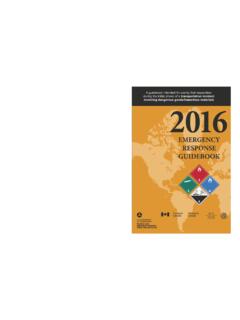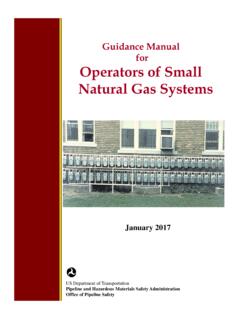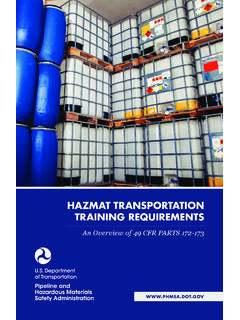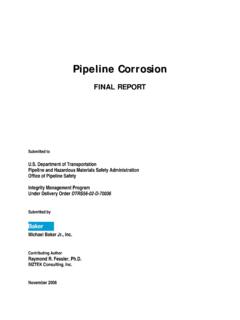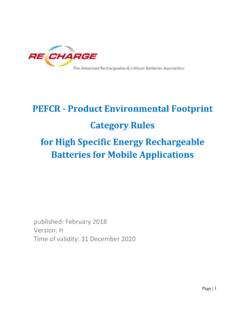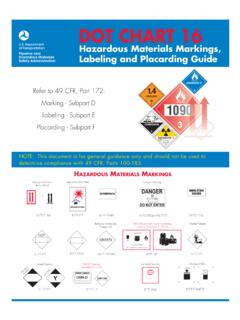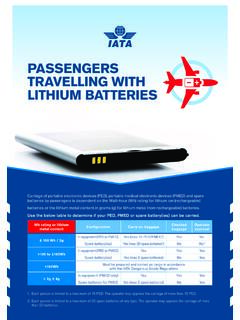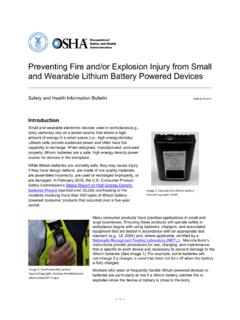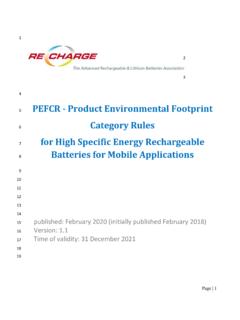Transcription of DOT CHART 16 Hazardous Materials Markings,Labeling and …
1 Fumigant Marking (g) and CHART 16 NOTE: This document is for general guidance only and should not be used to determine compliance with 49 CFR, Parts 100-185. Refer to 49 CFR, Part 172: Marking - Subpart D Labeling - Subpart EPlacarding - Subpart F Hazardous Materials Markings,Labeling and Placarding GuideHazardous Materials MarkingsorPackage Orientation(Red or Black) (a) (a)(4) Away from Heat (a)Biological Substances, Category B (a)(5) (a)Excepted Quantity (g)Marking of IBCs (b)(7)(i).. kg maxORM-DMarine Pollutant , Transition December 31, 2020UN1755 Limited QuantityAir OnlyAll other Modes Lithium battery handling marking, Transition December 31, 2018 Materials Warning LabelsActual label size: at least 100 mm ( inches) on all sidesCLASS 3 Flammable LiquidCLASS 4 Flammable Solid, Spontaneously Combustible, and Dangerous When Wet: Divisions , , Aircraft Only (b), , , 5 Oxidizer, Organic Peroxide: Divisions and , , , , CLASS 8 Corrosive CLASS 7 RadioactiveCLASS 9 Miscellaneous Hazardous MaterialSubsidiary Risk Label CLASS 2 Gases:Divisions , , 6 Poison (Toxic), Poison Inhalation Hazard, Infectious Substance: Divisions and Label* Include compatibility group letter.
2 ** Include division number and compatibility group 1 Explosives:Divisions , , , , , , , , For Regulated Medical Waste (RMW), an Infectious Substance label is not required on an outer packaging if the OSHA Biohazard marking is used as prescribed in 29 CFR (g). A bulk package of RMW must display a BIOHAZARD marking. , (c), , , January 2019, the NEW Class 9 lithium battery handling label must be used for lithium battery Materials Warning PlacardsActual placard size: at least 250 mm ( inches) on all sides CLASS 2 GasesFor NON-FLAMMABLE GAS, OXYGEN (compressed gas or refrigerated liquid), and FLAMMABLE GAS, placard 454 kg (1,001 lbs.) or more gross weight. For POISON GAS (Division ), placard any quantity. For FLAMMABLE SOLID and SPONTANEOUSLY COMBUSTIBLE, placard 454 kg (1,001 lbs.) or more. For DANGEROUS WHEN WET (Division ), placard any quantity.* For Divisions , , or , enter division number and compatibility group letter, when required; placard any quantity.
3 For Divisions , , and , enter compatibility group letter, when required; placard 454 kg (1,001 lbs.) or POISON (PGl or PGII, other than inhalation hazard) and POISON (PGIII), placard 454 kg (1,001 lbs.) or more. For POISON-INHALATION HAZARD (Division ), inhalation hazard only, placard any quantity. Placard any quantity - packages bearing RADIOACTIVE YELLOW-III labels only. Certain low- specific-activity radioactive Materials in exclusive use will not bear the label, but the radioactive placard is required for exclusive-use shipments of low-specific- activity material and surface-contaminated objects trans-ported in accordance with (e) Table 1 and (a)(6).Not required for domestic transportation. A bulk packaging containing a Class 9 material must be marked with the appropriate ID number displayed on a Class 9 placard, an orange panel, or a white square-on-point freight container, unit-load device, transport vehicle, or rail car that contains non-bulk packages with two or more categories of Hazardous Materials that require different placards specified in Table 2 (e) may be placarded with DANGEROUS placards instead of the specific placards required for each of the Materials in Table 2.
4 However, when 1,000 kg (2,205 lbs.) or more of one category of material is loaded at one loading facility, the placard specified in Table 2 must be CORROSIVE, placard454 kg (1,001 lbs.) or 9 Miscellaneous , , , (f)(10), , OXIDIZER and ORGANIC PEROXIDE (other than TYPE B, temperature controlled), placard 454 kg (1,001 lbs.) or more. For ORGANIC PEROXIDE (Division ), Type B, temperature controlled, placard any quantity. 1 Explosives FLAMMABLE placard 454 kg (1,001 lbs.) or more. GASOLINE may be used in place of FLAMMABLE placard displayed on a cargo tank or portable tank transporting gasoline by highway. Placard combustible liquid transported in bulk. See (f)(2) for use of FLAMMABLE placard in place of COMBUSTIBLE. FUEL OIL may be used in place of COMBUSTIBLE on a cargo or portable tank transporting fuel oil not classed as a flammable liquid by 3 Flammable Liquid and Combustible Liquid CLASS 7 Radioactive CLASS 4 Flammable Solid, Spontaneously Combustible, and Dangerous When WetCLASS 8 CorrosiveDangerous CLASS 6 Poison (Toxic) and Poison Inhalation HazardCLASS 5 Oxidizer & Organic PeroxideSafety begins with communication!
5 (a)(2) (Vessel transport only).Limited QuantityMarking EXPLOSIVES .. EXPLOSIVES ..EXPLOSIVES ..POISON GAS ..DANGEROUS WHEN WET ..ORGANIC PEROXIDE ..POISON INHALATION HAZARD ..RADIOACTIVE1 .. (Organic peroxide, Type B, liquid or solid, temperature controlled).. ( Materials poisonous by inhalation (see ))..7 (Radioactive Yellow III label only).. 1 RADIOACTIVE placard also required for exclusive-use shipments of low-specific-activity material and surface-contaminated objects transported in accordance with (b)(4) and (5) or (c) of the of material (Hazard Class or division number and additional description, as appropriate)Placard nameTABLE ..Combustible Liquid .. (Other than organic peroxide, Type B, liquid or solid, temperature controlled) .. (Other than Materials poisonous by inhalation) .. ORM-D .. Category of material (Hazard Class or division number and additional description, as appropriate)Placard nameTABLE 2 LABELSSee 49 CFR, Part 172, Subpart E, for complete labeling regulations.
6 The Hazardous Materials Table [ , Col. 6] identifies the proper label(s) for the Hazardous material listed. Any person who offers a Hazardous material for transportation MUST label the package, if required [ (a)]. Labels may be affixed to packages when not required by regulations, provided each label represents a hazard of the material contained in the package [ ]. For labeling mixed or consolidated packages, see The appropriate hazard class or division number must be displayed in the lower corner of a primary and subsidiary hazard label [ (b)]. For classes 1,2,3,4,5,6, and 8, text indicating a hazard ( , CORROSIVE ) is NOT required on a primary or subsidiary label. The label must otherwise conform to Subpart E of Part 172 [ ]. Labels must be printed on or affixed to the surface of the package near the proper shipping name marking [ (a)]. When primary and subsidiary labels are required, they must be displayed next to each other [ (c)].
7 For a package containing a Division , PG III material, the POISON label specified in may be modified to display the text PG III instead of POISON or TOXIC. Also see (c). The ORGANIC PEROXIDE label [ ] indicates that organic peroxides are highly flammable. Use of the ORGANIC PEROXIDE label eliminates the need for a flammable liquid subsidiary label. The color of the border must be black and the color of the flame may be black or 49 CFR, Part 172, Subpart F, for complete placarding regulations. Each person who offers for transportation or transports any Hazardous material subject to the Hazardous Materials Regulations must comply with all applicable requirements of Subpart F [ ]. Placards may be displayed for a Hazardous material, even when not required, if the placarding otherwise conforms to the requirements of Subpart F of Part 172 [ (c)]. For other than Class 7 or the DANGEROUS placard, text indicating a hazard ( , FLAMMABLE ) is not required.
8 Text may be omitted from the OXYGEN placard only if the specific ID number is displayed on the placard [ (b)(3)]. For a placard corresponding to the primary or subsidiary hazard class of a material, the hazard class or division number must be displayed in the lower corner of the placard [ (b)(4)]. Except as otherwise provided, any bulk packaging, freight container, unit load device, transport vehicle or rail car containing any quantity of material listed in Table 1 must be placarded [ ]. When the aggregate gross weight of all Hazardous Materials in non-bulk packages covered in Table 2 is less than 454 kg (1,001 lbs.), no placard is required on a transport vehicle or freight container when transported by highway or rail [ (c)]. Notes: See (f)(10) for placarding Division , PG III Materials . Placarded loads require registration with USDOT. See for registration regulations. This CHART is available on line at the following link: General Guidelines on Use of Warning Labels and PlacardsIdentification number displaysIDENTIFICATION NUMBER MARKINGS ON ORANGE PANELS OR APPROPRIATE PLACARDS MUST BE DISPLAYED ON: (1) Tank Cars, Cargo Tanks, Portable Tanks, and other Bulk Packagings; (2) Transport vehicles or freight containers containing 4,000 kg (8,820 lbs.)
9 In non-bulk packages of only a single Hazardous material having the same proper shipping name and identification number loaded at one facility and transport vehicle contains no other material, Hazardous or otherwise; and (3) transport vehicles or freight containers containing 1,000 kg (2,205 lbs.) of non-bulk packages of Materials poisonous by inhalation in Hazard Zone A or B. See (a)(3), (c), , , , and Appropriate placard must be used with orange tables[ (e)] white background required for placard for highway- route-controlled quantity radioactive material and for rail shipment of certain explosives and poisons, and for flammable gas in a DOT 113 tank car ( and ).andorEXPLOSIVES .. EXPLOSIVES .. EXPLOSIVES .. FLAMMABLE GAS .. NON-FLAMMABLE GAS ..FLAMMABLE .. COMBUSTIBLE ..FLAMMABLE SOLID .. SPONTANEOUSLY COMBUSTIBLE .. OXIDIZER.
10 ORGANIC PEROXIDE .. POISON .. (None) .. CORROSIVE .. Class 9 (See (f)(9)) ..(None) .. For additional information contact: The Hazardous Materials Info Center 1-800-HMR-4922 (1-800-467-4922) E-mail: 16 Now Available AS FREE MOBILE APPPHH50-0160-0817

